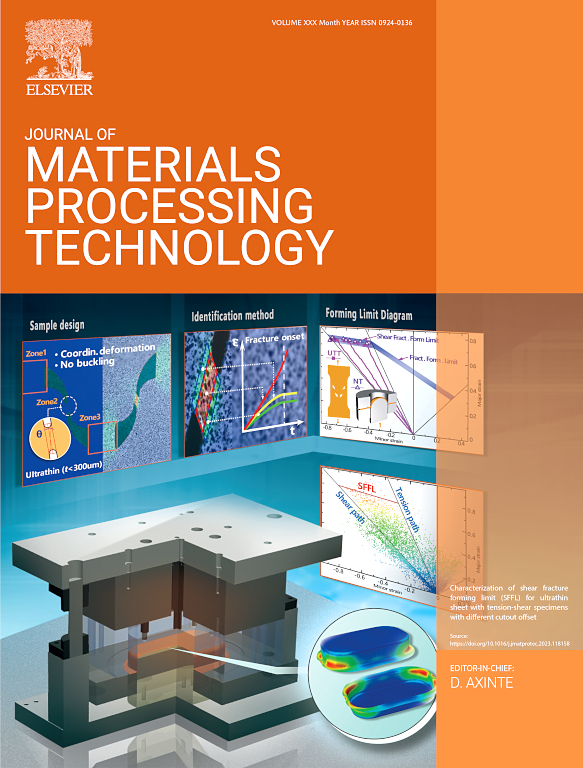Solid-state additive manufacturing of dissimilar 7075–2024 aluminum alloys by additive friction stir deposition: Interfacial bonding and process optimization
IF 7.5
2区 材料科学
Q1 ENGINEERING, INDUSTRIAL
Journal of Materials Processing Technology
Pub Date : 2025-07-16
DOI:10.1016/j.jmatprotec.2025.118989
引用次数: 0
Abstract
Additive Friction Stir Deposition (AFSD), an emerging solid-state additive manufacturing technique, has shown great promise in processing single aluminum alloys. However, its applicability to dissimilar aluminum alloys remains unclear. In this study, the feasibility of additive friction stir deposition for fabricating dissimilar 7075–2024 aluminum alloy structures was investigated for the first time. The effects of tool rotational speed (800–1400 rpm) on interfacial bonding, microstructural evolution, and mechanical properties were systematically studied. All deposited samples exhibited defect-free macrostructures within the studied range. Increasing the rotational speed resulted in grain refinement in the mid-layer regions of both 7075 and 2024, reaching minimum average grain sizes of 1.14 µm and 1.40 µm, respectively. The fraction of high-angle grain boundaries (HAGBs) increased significantly, reaching 86.1 % and 67.0 %, along with recrystallization fractions of 91.04 % and 84.39 % in 7075 and 2024 layers, respectively. At 1100 rpm, a uniform distribution of strengthening precipitates was observed, with the hardness reaching 75 % of the base materials and the highest tensile strength (181.9 MPa) and elongation (6.3 %) obtained. Further increases in rotational speed led to partial dissolution of precipitates due to excessive heat input, reducing hardness. While additive friction stir deposition was proven effective for fabricating dissimilar aluminum alloys, the tensile properties in the build direction (BD) were noticeably inferior to those in the longitudinal direction (LD). This study demonstrates that large-area joining of dissimilar aluminum alloys can be achieved via the AFSD process, providing a novel approach for the bonding of dissimilar alloys and laying a theoretical foundation for the AFSD fabrication of such materials.
添加剂搅拌摩擦沉积制备7075-2024异种铝合金:界面结合及工艺优化
添加剂搅拌摩擦沉积(AFSD)是一种新兴的固态增材制造技术,在加工单一铝合金方面具有广阔的前景。然而,它对不同铝合金的适用性尚不清楚。本文首次研究了添加剂搅拌摩擦沉积制备不同7075-2024铝合金结构的可行性。系统研究了刀具转速(800 ~ 1400 rpm)对界面结合、微观组织演变和力学性能的影响。所有沉积样品在研究范围内均表现出无缺陷的宏观结构。随着转速的增加,7075和2024的中间层区域晶粒细化,平均晶粒尺寸分别达到1.14 µm和1.40 µm。7075层和2024层的高角晶界(HAGBs)分数分别达到86.1 %和67.0 %,再结晶分数分别达到91.04 %和84.39 %。在1100 rpm时,强化相分布均匀,硬度达到母材的75 %,抗拉强度达到181.9 MPa,延伸率达到6.3 %。转速的进一步增加导致由于过多的热量输入导致析出物的部分溶解,从而降低硬度。添加剂搅拌摩擦沉积是制备异种铝合金的有效方法,但在构建方向(BD)的拉伸性能明显不如纵向(LD)的拉伸性能。该研究表明,通过AFSD工艺可以实现异种铝合金的大面积连接,为异种合金的连接提供了一种新的方法,为此类材料的AFSD制造奠定了理论基础。
本文章由计算机程序翻译,如有差异,请以英文原文为准。
求助全文
约1分钟内获得全文
求助全文
来源期刊

Journal of Materials Processing Technology
工程技术-材料科学:综合
CiteScore
12.60
自引率
4.80%
发文量
403
审稿时长
29 days
期刊介绍:
The Journal of Materials Processing Technology covers the processing techniques used in manufacturing components from metals and other materials. The journal aims to publish full research papers of original, significant and rigorous work and so to contribute to increased production efficiency and improved component performance.
Areas of interest to the journal include:
• Casting, forming and machining
• Additive processing and joining technologies
• The evolution of material properties under the specific conditions met in manufacturing processes
• Surface engineering when it relates specifically to a manufacturing process
• Design and behavior of equipment and tools.
 求助内容:
求助内容: 应助结果提醒方式:
应助结果提醒方式:


